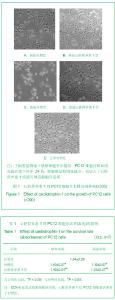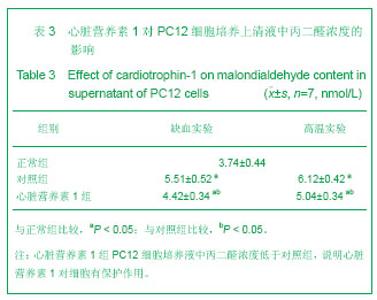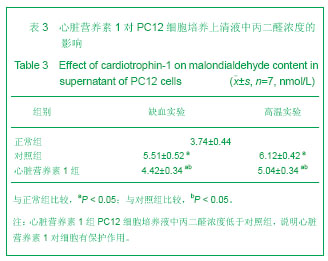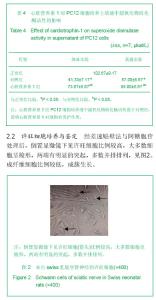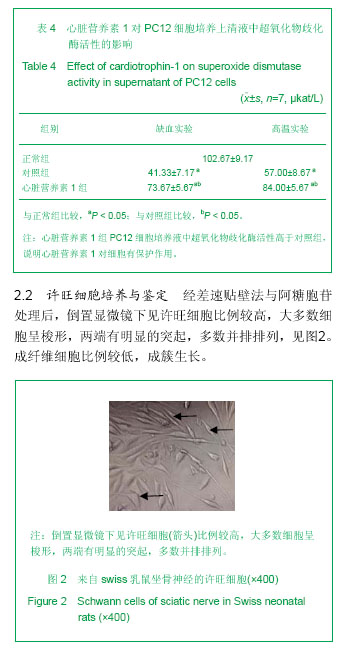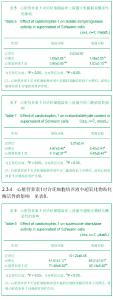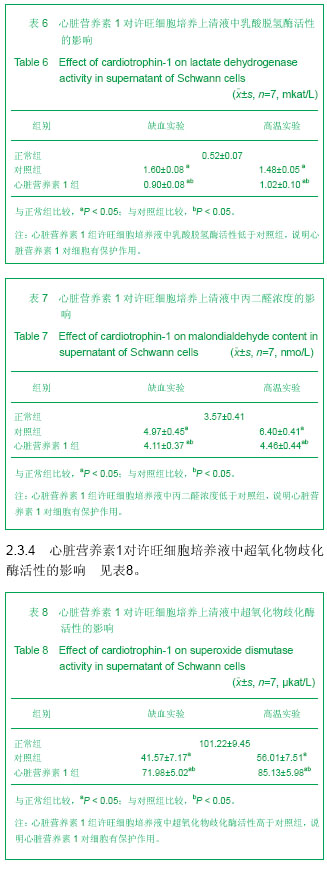Chinese Journal of Tissue Engineering Research ›› 2013, Vol. 17 ›› Issue (41): 7265-7271.doi: 10.3969/j.issn.2095-4344.2013.41.012
Previous Articles Next Articles
Exogenous cardiotrophin-1: The possibility to protect PC12 cells and Schwann cells
Xin Ze-tuan1, Liu Xiang-ze2, Zhang Ming-jin2, Li Wei2, Chen Bo-hua2, Ma Xue-xiao2
- 1Department of Orthopedics, People’s Hospital in Chengyang District, Qingdao 266100, Shandong Province, China; 2Department of Spinal Surgery, Affiliated Hospital of Qingdao University Medical College, Qingdao 266003, Shandong Province, China
-
Received:2013-06-09Revised:2013-07-30Online:2013-10-08Published:2013-11-01 -
Contact:Ma Xue-xiao, M.D., Associate chief physician, Associate professor, Master’s supervisor, Department of Spinal Surgery, Affiliated Hospital of Qingdao University Medical College, Qingdao 266003, Shandong Province, China ma_xuexiao@126.com -
About author:Xin Ze-tuan, Attending physician, Department of Orthopedics, People’s Hospital in Chengyang District, Qingdao 266100, Shandong Province, China -
Supported by:Natural Science Foundation of Shandong Province, No. Y2008C41*
CLC Number:
Cite this article
Xin Ze-tuan, Liu Xiang-ze, Zhang Ming-jin, Li Wei, Chen Bo-hua, Ma Xue-xiao. Exogenous cardiotrophin-1: The possibility to protect PC12 cells and Schwann cells[J]. Chinese Journal of Tissue Engineering Research, 2013, 17(41): 7265-7271.
share this article
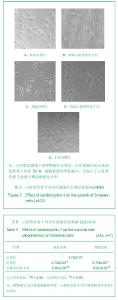
2.3 心脏营养素1对许旺细胞的保护作用 2.3.1 心脏营养素1对许旺细胞存活率的影响 细胞计数板计数分析显示缺血环境下许旺细胞存活率为60%,加入心脏营养素1组细胞存活率为85%,见图3。热应激作用下细胞的存活率仅为40%,心脏营养素1组细胞存活率为80%,见图3。酶标仪检测得到的A值见表5。加入了心脏营养素1的实验组对细胞的保护作用与对照组相比差异有显著性意义(P < 0.05)。 2.3.2 心脏营养素1对许旺细胞培养液中乳酸脱氢酶活性的影响 缺血对照组和高温对照组的许旺细胞培养液中的乳酸脱氢酶活性较正常组乳酸脱氢酶活性明显增高,为正常组的3.97、2.87倍,加入心脏营养素1的缺血心脏营养素1组和高温心脏营养素1组的乳酸脱氢酶活性增高程度较对照组明显降低,为正常组的1.74、1.97倍,结果见表6。心脏营养素1组与对照组相比差异有显著性意义 (P < 0.05),说明心脏营养素1对细胞有保护作用."
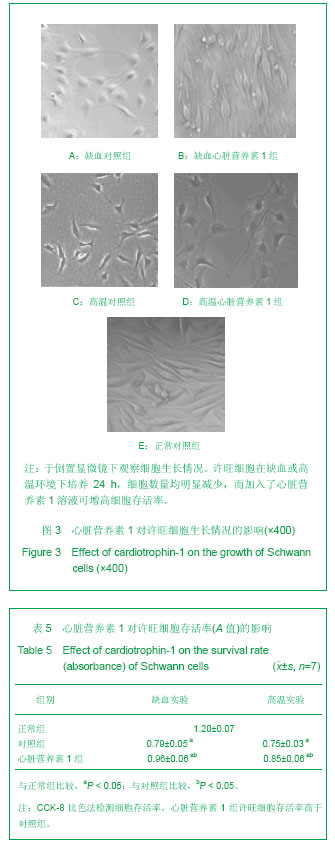
| [1] 张大鹏,潘世奇,侯明明等.周围神经损伤后最佳修复时间时机的选择[J].中国组织工程研究与临床康复,2010,14(20): 3726-3729. [2] Fernandez-Espejo E. Pathogenesis of Parkinson's disease:prospects of neuroprotective and restorative therapies. Mol Neurobiol. 2004;29(1):15-30. [3] Pennica D, Shaw KJ, Swanson TA, et al. Cardiotrophin-1. Biological activities and binding to the leukemia inhibitory factor receptor/gp130 signaling complex. J Bio Chem. 1995; 270(18):10915-10922. [4] 马学晓,张高孟,冯勇,等.心脏营养素1对失神经骨骼肌的营养和保护作用[J].中华手外科杂志,2006,22:112-115. [5] Hongkui Jin, Renhui Yang, Gilbert A. Keller Anne Ryan, et al. In vivo effects of cardiotrophin-1. Cytokin. 1996;8(12): 920-926. [6] Jiménez-González M, Jaques F, Rodríguez S, et al. Cardiotrophin 1 protects beta cells from apoptosis and prevents streptozotocin-induced diabetes in a mouse model. Diabetologia. 2013;56(4):838-846. [7] Quiros Y, Sánchez-González PD, López-Hernández FJ, et al. Cardiotrophin-1 administration prevents the renal toxicity of iodinated contrast media in rats. Toxicol Sci. 2013;132(2): 493-501. [8] Bustos M, Dubrot J, Martinez-Anso E, et al. Cardiotrophin-1 determines liver engraftment of syngenic colon carcinoma cells through an immune system-mediated mechanism. Oncoimmunology. 2012;1(9):1527-1536. [9] García-Cenador MB, Lopez-Novoa JM, Díez J, et al. Effects and mechanism of organ protection by cardiotrophin-1. Curr Med Chem. 2013;20(2):246-256. [10] ThierNichael, Hall Mark, Heath JK, et al. Trophic effects of cardiotrophin-1 and interleukin-11 on rat dorsal root ganglion neurons in vitro. Molecular Brain Res. 1999;64(1):80-84. [11] Wollert KC, Taga T, Saito M, et al. Cardiotrophin-1 activates a distinct form of cardiac muscle cell hypertrophy. J Biol Chem. 1996;271(16):9535-9545. [12] Heinrich PC, Behrmann I, Muller-Newen G, et al. Interleukin- 6- type cytokine signalling through the gp130/Jak/STAT pathway. Biochem J. 1998;334(Pt 2):297-314. [13] Ruiz-Hurtado G, Gómez-Hurtado N, Fernández-Velasco M, et al. Cardiotrophin-1 induces sarcoplasmic reticulum Ca(2+) leak and arrhythmogenesis in adult rat ventricular myocytes. Cardiovasc Res. 2012;96(1):81-89. [14] Li T, Wiggins LM, von Bartheld CS. Insulin-like growth factor-1 and cardiotrophin 1 increase strength and mass of extraocular muscle in juvenile chicken. Invest Ophthalmol Vis Sci. 2010;51(5):2479-2486. [15] 张正丰,廖维宏,杨青峰.重组心脏营养素-1对成年大鼠坐骨神经损伤后脊髓前角运动神经元存活的研究[J].中华实验外科杂志, 2004,21(1):116. [16] Oppenheim RW, Wiese S, Prevette D, et al. Cardiotrophin-1, a muscle-derived cytokine, is required for the survival of subpopulations of developing moto neurons. J Neurosci. 2001;21(4):1283-1291. [17] Wang D, Li X, Gao K, et al. Cardiotrophin-1 (CTF1) ameliorates glucose-uptake defects and improves memory and learning deficits in a transgenic mouse model of Alzheimer's disease. Pharmacol Biochem Behav. 2013;107: 48-57. [18] Shu X, Du S, Chen X, Li Z. Transplantation of neural stem cells overexpressing cardiotrophin-1 inhibits sprouting of hippocampal mossy fiber in a rat model of status epilepticus. Cell Biochem Biophys. 2011;61(2):367-70. [19] Grumbles RM, Sesodia S, Wood PM, et al. Neurotrophic factors improve motoneuron survival and function of muscle reinnervated by embryonic neurons. J Neuropathol Exp Neurol. 2009;68(7):736-46. [20] Habecker BA, Sachs HH, Rohrer H, et al. The dependence on gp130 cytokines of axotomy induced neuropeptide expression in adult sympathetic neurons. Dev Neurobiol. 2009;69(6):392-400. [21] Sango K, Yanagisawa H, Komuta Y, et al. Neuroprotective properties of ciliary neurotrophic factor for cultured adult rat dorsal root ganglion neurons. Histochem Cell Biol. 2008; 130(4):669-679. [22] 杨云华,廖维宏,伍亚民,等.腺病毒介导的心肌营养素-1基因转染对神经干细胞作用的实验研究[J].中国脊柱脊髓杂志,2005, 15(6): 361-364. [23] Sakamoto T, Kawazoe Y, Shen JS, et al. Adenoviral gene transfer of GDNF, BDNF and TGF beta 2, but not CNTF, cardiotrophin-1 or IGF1, protects injured adult motoneurons after facial nerve avulsion. J Neurosci Res. 2003;72(1):54-64. [24] Bordet T, Lesbordes JC, Rouhani S, et al. Protective effects of cardiotrophin-1 adenoviral gene transfer on neuromuscular degeneration in transgenic ALS mice. Hum Mol Genet. 2001; 10(18):1925-1933. [25] Tang XQ, Feng JQ, Chen J, et al. Protection of oxidative preconditioning against apoptosis induced by H2O2 in PC12 cells: Mechanisms via MMP, ROS and Bcl-2. Brain Res. 2005; 1057(1-2):57-64. [26] Zhan Y, Ma DH, Zhang Y. Effects of cotransplantated Schwann cells and neural stem cells in a rat model of Alzheimer’s disease. Neura Regen Res. 2011;6(4): 245-251. [27] Ye FG, Li HY,Qiao GX, et al. Platelet-rich plasma gel in combination with Schwann cells for repair of sciatic nerve injury. Neural Regen Res. 2012;7(29): 2286-2292. [28] 侯春梅,李新颖,叶伟亮,等.MTT法和CCK-8法检测悬浮细胞增殖的比较[J].军事医学科学院院刊,2009,33(4):400-401. [29] Latchman DS. Cardiotrophin-1: a novel cytokine and its effects in the heart and other tissues. Pharmacol Ther. 2000; 85(1):29-37. [30] López N, Díez J, Fortuño MA. Characterization of the protective effects of cardiotrophin-1 against non-ischemic death stimuli in adult cardiomyocytes. Cytokine. 2005; 30(5): 282-292. [31] Zvonic S, Hogan JC, Arbour-Reily P, et al. Effects of cardiotrophin on adipocytes. J Biol Chem. 2004;279(46): 47572-47579. [32] 李同欢,李振宏,杜淑珍,等.Adv-CT1转染对神经元的作用[J].遵义医学院学报,2010,33(5):428-430. |
| [1] | Zhang Yong-duo, Pan De-yue, Li Xue-liang, Zhao Wen-zhi. Posterior malleolar fractures: how to choose in the face of diversified treatment? [J]. Chinese Journal of Tissue Engineering Research, 2018, 22(23): 3744-3750. |
| [2] | Jiang Zi-wei, Huang Feng, Cheng Si-yuan, Zheng Xiao-hui, Sun Shi-dong, Zhao Jing-tao, Cong Hai-chen,Sun Han-qiao, Dong Hang. Design and finite element analysis of digital splint [J]. Chinese Journal of Tissue Engineering Research, 2017, 21(7): 1052-1056. |
| [3] | Wang Fei, Liu Zhi-bin, Tao Hui-ren, Zhang Jian-hua, Li Chang-hong, Cao Qiang, Zheng Jun, Liu Yan-xiong, Qu Xiao-peng. Clinical efficacy of preoperative osteotomy designs using paper-cut technology versus photoshop software for ankylosing spondylitis with kyphosis [J]. Chinese Journal of Tissue Engineering Research, 2017, 21(7): 1057-1063. |
| [4] | Li Hui, Ma Jun-yi, Ma Yuan, Zhu Xu . Establishment of a three-dimensional finite element model of ankylosing spondylitis kyphosis [J]. Chinese Journal of Tissue Engineering Research, 2017, 21(7): 1069-1073. |
| [5] | Ling Guan-han, Ou Zhi-xue, Yao Lan, Wen Li-chun, Wang Guo-xiang, Lin Heng-feng. Establishment of simulating three-dimensional model of China-Japan Friendship Hospital Classification for L type osteonecrosis of the femoral head [J]. Chinese Journal of Tissue Engineering Research, 2017, 21(7): 1074-1079. |
| [6] | Fu Wei-min, Wang Ben-jie. Assessing the degree of necrotic femoral head, and association of blood supply with pathlogical changes: study protocol for a diagnostic animal trial [J]. Chinese Journal of Tissue Engineering Research, 2017, 21(7): 1086-1091. |
| [7] | Zhang Wen-qiang, Ding Qian, Zhang Na. Associations between alpha angle and herniation pit on oblique axial magnetic resonance imaging in asymptomatic hip joints of adults [J]. Chinese Journal of Tissue Engineering Research, 2017, 21(7): 1098-1103. |
| [8] | Sun Xiao-xin1, Zhou Wei2, Zuo Shu-ping3, Liu Hao1, Song Jing-feng1, Liang Chun-yu1. Morphological characteristics for the magnetic resonance imaging assessment of discoid lateral meniscal tears in children [J]. Chinese Journal of Tissue Engineering Research, 2017, 21(7): 1104-1109. |
| [9] | Lin Han-wen, Wen Jun-mao, Huang Chao-yuan, Zhou Chi, Tang Hong-yu. Correlation between the changes in lower limb power line and pain area in the knee osteoarthritis patients: imaging evaluation [J]. Chinese Journal of Tissue Engineering Research, 2017, 21(7): 1110-1114. |
| [10] | Zhang Yun-ge, Song Ke-guan. Periprosthetic osteolysis induced by wear particles: research progress of calcineurin/activated T cell nuclear factor signaling pathway [J]. Chinese Journal of Tissue Engineering Research, 2017, 21(7): 1115-1122. |
| [11] | Liu Wei, Huang Jian. Applied research and progress of three-dimensional printing technology in joint replacement [J]. Chinese Journal of Tissue Engineering Research, 2017, 21(7): 1123-1130. |
| [12] | Liu Jian-kun, Deng Shu-cai. Status and role of three-dimensional printing technology in spine surgery [J]. Chinese Journal of Tissue Engineering Research, 2017, 21(7): 1131-1136. |
| [13] | Xi Li-cheng, Li Hong-yu. Research progress of the influence of alcohol on the local microenvironment of femoral head [J]. Chinese Journal of Tissue Engineering Research, 2017, 21(7): 1137-1142. |
| [14] | Ye Xiang-yang, Sun Xiang, Tang Li-xin, Zhen Ping, Geng Bin, Wang Hua-lei, Zhao Yu-guo. Acetabular liner wear of cross-linked versus conventional polyethylene for total hip arthroplasty: a meta-analysis [J]. Chinese Journal of Tissue Engineering Research, 2017, 21(7): 1143-1148. |
| [15] | Shi Bin, An Jing, Chen Long-gang, Zhang Nan, Tian Ye . Influencing factors for pain after total knee arthroplasty [J]. Chinese Journal of Tissue Engineering Research, 2017, 21(7): 993-997. |
| Viewed | ||||||
|
Full text |
|
|||||
|
Abstract |
|
|||||
